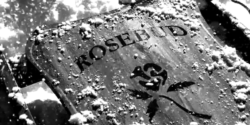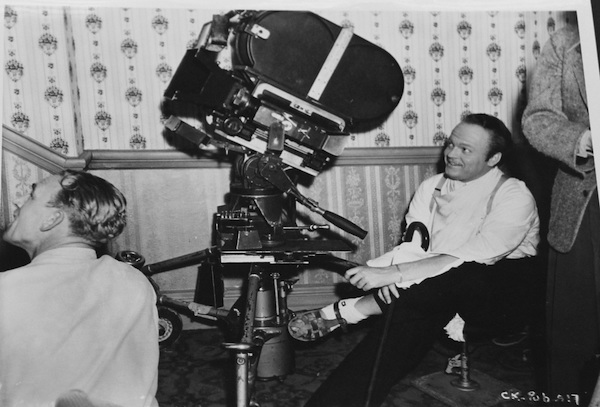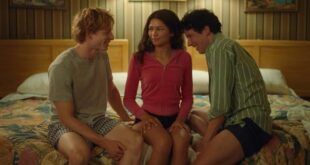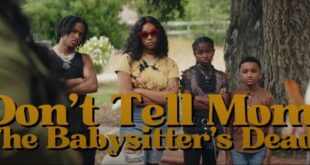In the first edition of CANON OF FILM, we take a look at ‘Citizen Kane‘ in honor of it’s 76th birthday earlier this week. You can find the backstory on the inception of CANON OF FILM here.
CITIZEN KANE (1941)
Director: Orson Welles
Director of Photography: Gregg Toland
Screenplay: Howard J. Mankiewicz & Orson Welles
The more one knows about film and filmmaking, the more one will appreciate ‘Citizen Kane‘. That’s not to say that you won’t like it without having a wide knowledge of film, but it seems to help many people, at least those who wonder how it keeps being ranked #1 on practically every greatest film poll for the last 50+ years or so, (Or at least used to until ‘Vertigo’ finally topped it on Sight & Sound’s 2012 list) yet, ‘Citizen Kane’ really is the kind of film that’s more interesting to study than it might be to watch. In hindsight, this seems purposeful. It’s one thing for a movie to reinvent the way movies are made, but it’s another to show it off so much.
 The skill is Orson Welles showing how talented and creative he can be, the insistence of showing just how talented he is, that is his ego at work. Take the scene where Kane (Welles) and Leland (Joseph Cotton) enter the Enquirer newspaper for the first time. The invention in this scene, a ceiling. There never was a ceiling in a movie until ‘Citizen Kane,’ because nobody could then figure out how to record sound with one, the boom had to come from above if needed. He figured out how to hide tiny mikes in the ceiling, and other places in the office, and the compression of the scene must have been jaw-dropping for it’s first audiences, even if they weren’t exactly sure why. A later scene at that same newspaper, takes place after Kane has lost his bid for Governor, and him and Leland are having a conversation about the future. He shoots the entire scene, without a cut, but also from a very low ground level angle, in fact it’s below ground level (He built a trap door in the set for the camera to get that low-level shot), to underline just how low a point this is in Kane’s life. The ceiling really becomes showcased now, with this shot, but there’s no need for it to be shot from this extremely low angle. Is it just an aesthetic choice? Yes, but Welles know how he’s reinventing the wheel, and he wants to let other know about it with a bang, and not a whisper.
The skill is Orson Welles showing how talented and creative he can be, the insistence of showing just how talented he is, that is his ego at work. Take the scene where Kane (Welles) and Leland (Joseph Cotton) enter the Enquirer newspaper for the first time. The invention in this scene, a ceiling. There never was a ceiling in a movie until ‘Citizen Kane,’ because nobody could then figure out how to record sound with one, the boom had to come from above if needed. He figured out how to hide tiny mikes in the ceiling, and other places in the office, and the compression of the scene must have been jaw-dropping for it’s first audiences, even if they weren’t exactly sure why. A later scene at that same newspaper, takes place after Kane has lost his bid for Governor, and him and Leland are having a conversation about the future. He shoots the entire scene, without a cut, but also from a very low ground level angle, in fact it’s below ground level (He built a trap door in the set for the camera to get that low-level shot), to underline just how low a point this is in Kane’s life. The ceiling really becomes showcased now, with this shot, but there’s no need for it to be shot from this extremely low angle. Is it just an aesthetic choice? Yes, but Welles know how he’s reinventing the wheel, and he wants to let other know about it with a bang, and not a whisper.
He does this throughout the movie. The large windows and statues that seem normal when characters are in the foreground, but are comically large when they move into the background. The breakfast scene which shows a marriage deteriorated to the point that the table grows and the distance between the couple become longer and longer, and with so much stuff on it, that the table now resembles a casket at a funeral. The window remains in the same spot in the frame in the opening, even as the camera comes closer and closer to Kane’s home, Xanadu. These are but a handful of dozens, maybe hundreds of details Welles’s has layered upon ‘Citizen Kane,’ and yet, you can watch this film, no — study this film — dozens of times, and still not catch everything he’s doing. Welles was a genius who had the world on a string, and was young and cocky to pull and twist that string ‘til it broke.
 The famous “Rosebud,” is a gimmick, pure and simple. An excuse to find out about Kane’s life. The fact that it’s his childhood sled explains everything, but it also explains nothing. Make of it what you wish. In reality, “Rosebud” was a word that William Randolph Hearst used to call a certain favorite body part of his mistress, Marion Davies. (Use your imagination as to what body part.) On the two-disc DVD, there’s a great Oscar-nominated documentary ‘The Battle Over Citizen Kane,’ which I also highly recommend, that shows the lives of both Hearst and Welles up to and including the famous confrontation over this film. It also details Welles’s pre-cinema work, including the intimate details about Welles’s famous ‘War of the Worlds,’ radio broadcast, which helped him get the RKO film deal. If you’ve ever studied that broadcast, they you’d already realized how ingenious Orson Welles really was.
The famous “Rosebud,” is a gimmick, pure and simple. An excuse to find out about Kane’s life. The fact that it’s his childhood sled explains everything, but it also explains nothing. Make of it what you wish. In reality, “Rosebud” was a word that William Randolph Hearst used to call a certain favorite body part of his mistress, Marion Davies. (Use your imagination as to what body part.) On the two-disc DVD, there’s a great Oscar-nominated documentary ‘The Battle Over Citizen Kane,’ which I also highly recommend, that shows the lives of both Hearst and Welles up to and including the famous confrontation over this film. It also details Welles’s pre-cinema work, including the intimate details about Welles’s famous ‘War of the Worlds,’ radio broadcast, which helped him get the RKO film deal. If you’ve ever studied that broadcast, they you’d already realized how ingenious Orson Welles really was.
To go through all the incredible film achievements, innovations and symbolism in ‘Citizen Kane,’ would involve typing a couple hundred more pages; I’ve seen film textbooks with chapters devoted just to ‘Citizen Kane,’ some that even split cinema into eras before and after the film, and it’s not hard to see why. Even watching a movie like ‘Casablanca‘ just a year later, that movie wasn’t directed by a great cinema auteur of any big note and the changes are quite drastic. Welles did notably give his comrade, Cinematographer Gregg Toland a rare equal billing with him as a Director because he was grateful for all he learned from him. (So I, as above, have also given him an equal billing) It’s won practically every Best Picture of all-time prize since it was finally re-released to the public in 1956, shortly after Hearst’s death, although it only won a single Oscar for the film’s screenplay. (And most think that was just Hollywood giving Mankiewicz an award, since he was close to a lot of the Hollywood elite) It’s the one film that can continue to surprise and intrigue us the more we study it, even decades later. It takes a genius to make such a groundbreaking film. It took someone as smart and cocky as Welles to come along and actually make it. Oh by the way, keep this is mind when watching some of those scenes where Kane is in full aged make-up — Welles was only 23 when he made it.

 Age of The Nerd
Age of The Nerd




